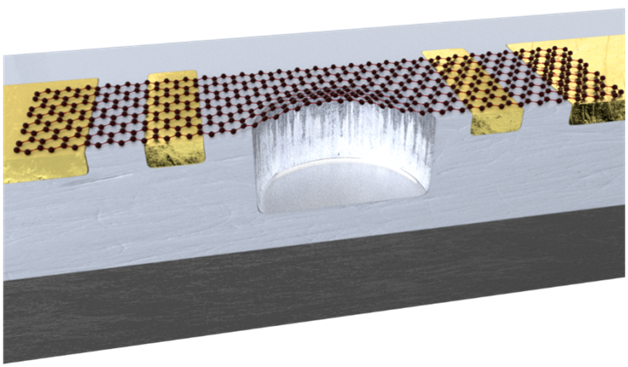Nanoelectromechanical sensors made of 2D materials
Max Lemme and colleagues recently published an review article on nanoelectromechanical (NEMS) sensors based on floating two-dimensional (2D) materials in the magazine RESEARCH. This is a multidisciplinary open access journal that was launched in 2018 as the first journal in the Science Partner Journal (SPJ) program. The paper is an “Invited Paper” for a special edition entitled “Progress and challenges in emerging 2D nanomaterials preparation, processing and device integration” with the aim of developing the area of 2D materials for sensor applications and integrating them into conventional semiconductor technology to contribute.

“I believe that NEMS sensors based on 2D materials will make a significant contribution to meeting the demand for integrated, high-performance sensors that result from applications such as the Internet of Things (IoT) and autonomous mobility,” said Lemme. The paper summarizes the many studies that have successfully demonstrated the feasibility of using membranes made of 2D materials in pressure sensors, microphones, mass and gas sensors. It explains the different sensor concepts and gives an overview of the relevant material properties, production methods and functional principles of the devices.
“Two-dimensional materials are ideal for sensors,” says Lemme, “because they allow free-standing structures to be realized that are only a few atoms thick. This ultimate thinness can be a decisive advantage with nanoelectromechanical sensors, since the performance is often crucially dependent on the thickness of the suspended component depends. In addition, many 2D materials have unique electrical, mechanical and optical properties that can be used for completely new concepts of sensor devices.”
The review contains contributions from RWTH Aachen, AMO GmbH, the University of the Bundeswehr in Munich, the KTH Royal Institute of Technology, TU Delft, Infineon and the Kavli Institute of Nanoscience. The different readout and integration methods of different sensors based on 2D materials are discussed here, and they offer comparisons with the state of the art to demonstrate both the challenges and the promises of nanoelectromechanical sensors based on 2D materials.
“Sensor devices based on floating 2D materials are almost always smaller than their conventional counterparts, have improved performance and sometimes even completely new functionalities,” says Peter G. Steeneken, head of work package 6 (sensors) in the Graphene flagship and co-author of the contribution. “However, there are still enormous challenges to show that NEMS sensors based on 2D materials can outperform conventional devices in all important aspects – for example in establishing profitable manufacturing options. The graphene flagship represents the ideal platform to addressing these challenges as it encourages collaboration between leading global groups to achieve a number of clearly defined goals. This paper is an example of how we can do more by bringing together complementary expertise.”
The work was supported financially by the European Commission within the project GrapheneFlagship [785219, 881603] and ULISSES [825272], by the German Federal Ministry of Education and Research (BMBF) within the project GIMMIK [03XP0210] and NobleNEMS [16ES1121], by German Federal Ministry for Economic Affairs, SMEs and Energy (BMWi) and the European Social Fund in Germany as part of the AachenCarbon [03EFLNW199] project, the Swedish Research Foundation (VR) (2015-05112), the FLAG-ERA project CO2DETECT (2017 -05108), the Dutch 4-TE joint project High Tech for a sustainable future and the FLAG-ERA project 2DNEMS (LE 2441/11) funded by the Swedish Research Foundation (VR) (2019-03412) and the German Research Foundation (DFG) -1).
Bibliographic information:
“Nanoelectromechanical Sensors based on Suspended 2D Materials”, M.C. Lemme, S. Wagner, K. Lee, X. Fan, G. Verbiest, S. Wittmann, S. Lukas, RJ Dolleman, F. Niklaus, HSJ van der Zant, G.S. Duesberg, P.G. Steeneken
RESEARCH | Vol. 2020 | Article ID 8748602 | https://doi.org/10.34133/2020/8748602
Contact:
Prof. Dr. Max C. Lemme
Email: lemme@amo.de
Article provided by Federica Haupt (AMO), translated by Mike Schwarz (Robert Bosch)
